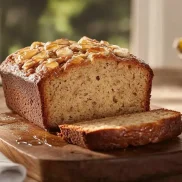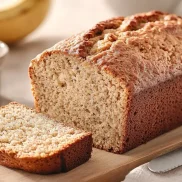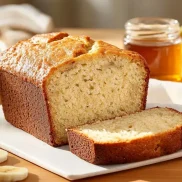Banana bread is a timeless favorite, loved for its moist texture and sweet, comforting flavor. While brown bananas are often hailed as the secret to the perfect loaf, many people wonder, “Can I make banana bread with bananas that aren’t brown?” The answer is a resounding yes! Whether you’re dealing with fresh yellow bananas or even slightly green ones, there’s a way to adapt your recipe and achieve delicious results. If you’re looking for a banana bread recipe with 2 bananas, check out this link. In this article, we’ll explore the role of bananas in banana bread, how ripeness impacts the final product, and tips for using bananas that aren’t brown.
Table of Contents
Understanding the Role of Bananas in Banana Bread
Why Are Brown Bananas Traditionally Used?
Brown bananas are the go-to choice for banana bread due to their naturally high sugar content and intense flavor. As bananas ripen, their starches convert into sugars, giving them a sweet and rich taste that enhances baked goods. The softer texture of brown bananas also blends seamlessly into batter, creating a smooth and moist consistency in the bread.
Traditionally, using brown bananas has been a clever way to reduce food waste by repurposing overripe fruit. These bananas, which might otherwise be discarded, bring out the dessert-like quality of banana bread. Their strong aroma and sweet profile are ideal for adding depth to recipes without additional sweeteners.
How Banana Ripeness Affects Flavor and Texture
Ripeness significantly impacts both the flavor and texture of banana bread. Green or less ripe bananas tend to have a starchy taste and a firmer texture, which can lead to a drier or denser bread if not prepared carefully. On the other hand, fully ripe bananas offer sweetness and moisture that balance the other ingredients, ensuring a flavorful and tender loaf.
Unripe bananas may not provide the caramelized notes that brown bananas naturally offer, but they can still be used creatively. For instance, adding a touch of honey or maple syrup can compensate for the lack of sweetness. Additionally, blending less ripe bananas thoroughly can help achieve the desired smooth consistency.
Nutritional Differences Between Ripe and Unripe Bananas
The nutritional profile of bananas changes as they ripen. Unripe bananas are higher in resistant starch, which acts as a prebiotic and supports gut health. They also have a lower glycemic index, making them a better choice for those managing blood sugar levels. However, the starchy taste may not appeal to everyone when used in banana bread.
As bananas ripen, their starches turn into simple sugars, increasing their caloric content slightly but enhancing their digestibility. Brown bananas are rich in antioxidants, which develop as the fruit ages. These antioxidants contribute to the deep, sweet flavor of the banana bread, making it a delicious yet nutrient-packed treat.
Using bananas at various stages of ripeness allows for experimentation in flavor and nutritional benefits. Whether you prefer the hearty taste of unripe bananas or the sugary richness of brown ones, there’s a way to make banana bread work for you.
Can I Make Banana Bread with Bananas That Aren’t Brown? Exploring Alternatives
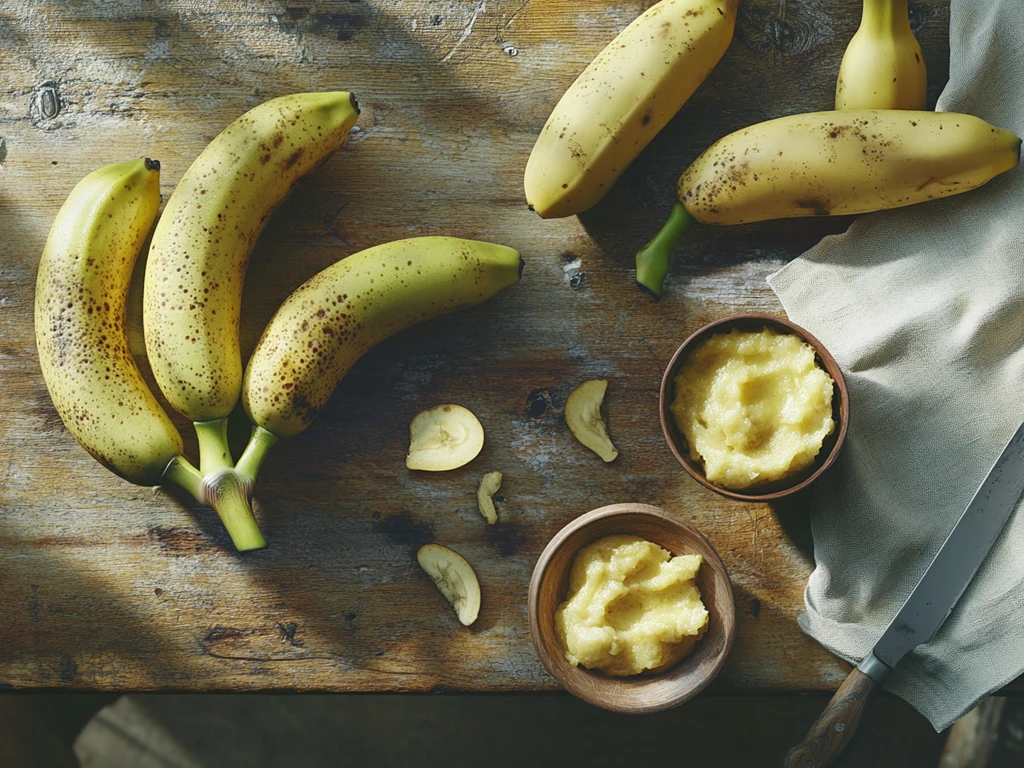
Using Fresh Yellow Bananas: Pros and Cons
Fresh yellow bananas are a viable alternative to brown bananas for making banana bread. These bananas, which are less ripe, offer a milder flavor compared to the intense sweetness of their brown counterparts. On the plus side, yellow bananas are firmer, making them easier to slice and incorporate into batter without becoming overly mushy.
However, there are a few drawbacks to consider. Yellow bananas lack the deep caramelized sweetness that brown bananas provide, which can result in a bread that tastes less rich and dessert-like. They also have a higher starch content, which might affect the bread’s texture, making it slightly denser if not properly balanced with other ingredients. To counteract this, you can add a small amount of extra sugar or a sweetener like honey to enhance the flavor profile.
How to Simulate the Flavor of Brown Bananas with Fresh Ones
If you only have fresh yellow bananas on hand, there are creative ways to simulate the rich sweetness of brown bananas. One effective method is to roast or bake the bananas. Place unpeeled bananas on a baking sheet and roast them in the oven at 300°F (150°C) for 15-20 minutes, or until the skins turn dark brown. This process caramelizes the natural sugars, bringing out a sweeter, more complex flavor similar to brown bananas.
Another technique is to mash the yellow bananas with a tablespoon of maple syrup or honey. This not only sweetens the mixture but also adds a touch of depth to the flavor. For added moisture, you can blend the bananas with a tablespoon of milk or yogurt before incorporating them into your batter.
Combining Different Stages of Bananas for a Balanced Flavor
For a balanced flavor and texture, consider combining bananas at different stages of ripeness. Using a mix of yellow and brown bananas allows you to enjoy the best of both worlds—the mild sweetness and structure of yellow bananas paired with the rich, sugary flavor of brown ones. This method is particularly useful if you have bananas ripening at different rates and want to avoid waste.
When using this approach, mash the bananas separately and blend them together gradually until the desired consistency and flavor are achieved. This ensures that the flavor is evenly distributed throughout the batter. Additionally, you can adjust the sweetness level by tweaking the ratio of yellow to brown bananas based on your personal preference.
By exploring these alternatives and techniques, you’ll find that making banana bread with bananas that aren’t brown is not only possible but also a chance to experiment with flavors and textures that suit your taste.
Techniques to Ripen Bananas Faster
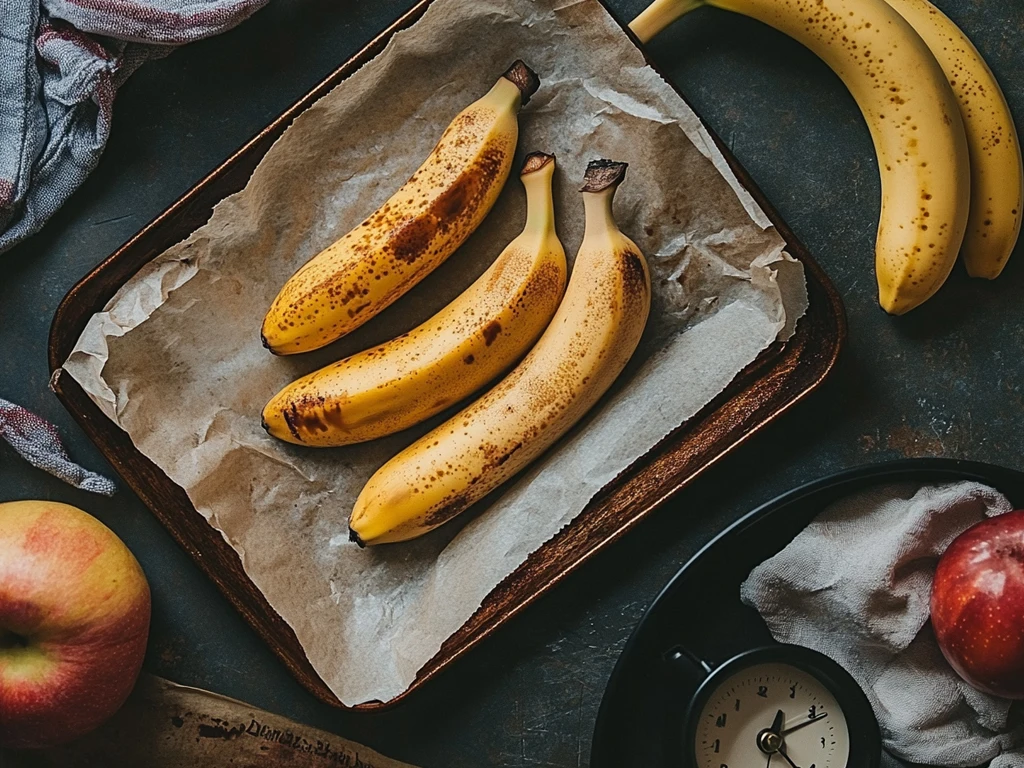
Oven-Baking: A Quick Method to Ripen Bananas
Oven-baking is a fast and reliable way to ripen bananas when time is of the essence. This method works by applying heat to break down the starches in bananas, converting them into sugars that enhance sweetness.
To use this technique, start by preheating your oven to 300°F (150°C). Place unpeeled bananas on a baking sheet lined with parchment paper or aluminum foil. Bake them for 15-20 minutes, or until the skins turn black and shiny. Allow the bananas to cool before peeling and using them in your recipe. The baking process softens the fruit, making it easy to mash and integrate into batters.
One advantage of oven-baking is its speed compared to natural ripening. However, keep in mind that the texture may be slightly different from naturally ripened bananas, as they’ll be softer and more caramelized. This method is particularly effective when you need ripe bananas for baking on short notice.
Freezing and Thawing: Unlocking Sweetness in Fresh Bananas
Freezing and thawing bananas is another quick method to mimic the ripeness of brown bananas. When bananas are frozen, their cellular structure breaks down, softening the fruit and enhancing its natural sweetness upon thawing.
To try this method, peel your bananas and place them in an airtight container or freezer bag. Freeze them for at least 2-3 hours or overnight if time allows. When ready to use, remove the bananas from the freezer and let them thaw at room temperature for 30-60 minutes. You can also microwave them on a low setting for a quicker thaw.
Thawed bananas will be soft and easy to mash, making them perfect for banana bread. While the flavor profile won’t be identical to naturally ripened bananas, the sweetness will be comparable, and the texture will blend seamlessly into your batter.
Paper Bag Method: Natural Ripening Tips
If you have a little more time, the paper bag method is an effective way to accelerate the ripening process naturally. This technique traps ethylene gas—a natural ripening agent—around the bananas, speeding up the process.
To use this method, place your bananas in a brown paper bag. For even faster results, add an apple or a ripe avocado to the bag, as these fruits emit additional ethylene gas. Fold the top of the bag loosely to maintain airflow while containing the gas. Store the bag at room temperature, and check the bananas daily. Depending on their initial ripeness, they should be ready in 1-3 days.
The paper bag method is ideal if you have a little patience and prefer a natural ripening approach. It’s also a great way to ripen multiple bananas simultaneously without needing any special equipment.
By using these techniques, you can ensure that your bananas are ripe and ready for baking, even if they start out less than perfect. Whether you choose oven-baking, freezing and thawing, or the paper bag method, you’ll have the tools to create delicious banana bread anytime.
Recipes and Variations for Banana Bread with Fresh Bananas
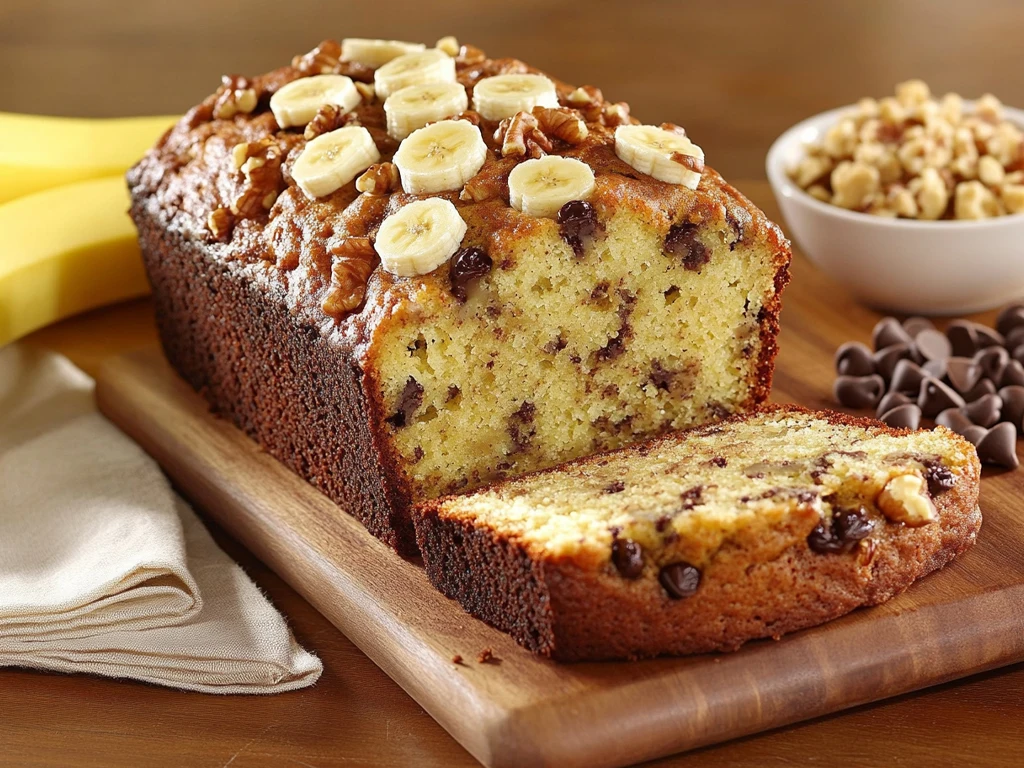
Classic Banana Bread Recipe Using Yellow Bananas
Using fresh yellow bananas to make banana bread is a simple and rewarding process. Here’s a classic recipe that brings out the best in these slightly less ripe fruits:
Ingredients:
- 2-3 medium yellow bananas (mashed)
- 1/2 cup unsalted butter (melted)
- 1 cup granulated sugar
- 2 large eggs
- 1 tsp vanilla extract
- 1 1/2 cups all-purpose flour
- 1 tsp baking soda
- 1/2 tsp salt
Instructions:
- Preheat your oven to 350°F (175°C) and grease a 9×5-inch loaf pan.
- In a large mixing bowl, combine mashed yellow bananas, melted butter, sugar, eggs, and vanilla. Mix until smooth.
- In a separate bowl, whisk together flour, baking soda, and salt. Gradually add the dry ingredients to the wet ingredients, stirring until just combined.
- Pour the batter into the prepared loaf pan and bake for 50-60 minutes, or until a toothpick inserted in the center comes out clean.
- Allow the bread to cool in the pan for 10 minutes before transferring it to a wire rack to cool completely.
This recipe produces a slightly denser bread with a milder banana flavor compared to using brown bananas. It’s perfect for those who prefer a less sweet loaf.
Enhancing Fresh Banana Bread with Spices and Add-Ins
Fresh banana bread can be elevated with the addition of spices and mix-ins. Here are some popular options to enhance flavor and texture:
Spices:
- Cinnamon: Adds warmth and complements the natural sweetness of bananas.
- Nutmeg: A pinch of nutmeg provides a subtle, aromatic flavor.
- Cardamom: Offers a unique floral note that pairs beautifully with bananas.
Add-Ins:
- Chopped Nuts: Walnuts or pecans add crunch and a nutty flavor.
- Chocolate Chips: A handful of semi-sweet or dark chocolate chips makes the bread feel more indulgent.
- Dried Fruits: Raisins, cranberries, or chopped dates bring a chewy texture and extra sweetness.
To incorporate these enhancements, simply fold them into the batter before pouring it into the loaf pan. Aim for 1/2 to 3/4 cup of add-ins to maintain the batter’s balance.
Gluten-Free Banana Bread with Less Ripe Bananas
For those with dietary restrictions, making gluten-free banana bread with yellow bananas is both easy and delicious. Here’s a foolproof recipe:
Ingredients:
- 2 medium yellow bananas (mashed)
- 1/2 cup almond flour
- 1 cup gluten-free all-purpose flour
- 1/4 cup coconut oil (melted)
- 1/2 cup coconut sugar
- 2 large eggs
- 1 tsp vanilla extract
- 1 tsp baking powder
- 1/4 tsp salt
Instructions:
- Preheat your oven to 350°F (175°C) and line a loaf pan with parchment paper.
- In a large bowl, combine mashed bananas, coconut oil, coconut sugar, eggs, and vanilla extract. Mix well.
- In another bowl, whisk together almond flour, gluten-free all-purpose flour, baking powder, and salt.
- Gradually mix the dry ingredients into the wet ingredients until a smooth batter forms.
- Pour the batter into the prepared pan and bake for 45-55 minutes, or until the top is golden brown and a toothpick inserted into the center comes out clean.
This gluten-free version is moist, flavorful, and ideal for those who want a healthier banana bread option. The yellow bananas add a mild sweetness that pairs well with the nutty almond flour.
These recipes and variations prove that fresh bananas can create delectable banana bread, offering endless opportunities to experiment with flavors and dietary adaptations.
Storage, Serving, and Longevity of Banana Bread
How Long Does Banana Bread Last When Made with Fresh Bananas?
Banana bread made with fresh bananas can last for several days when stored correctly. Typically, it remains fresh for up to 3-4 days at room temperature. If you refrigerate it, the bread can stay good for about a week, while freezing it extends its shelf life to 2-3 months.
The freshness of banana bread depends on its moisture content. Recipes using yellow bananas may be slightly less sweet and moist than those using brown bananas, but they still hold up well when stored properly. Always check for signs of spoilage, such as mold or an off smell, before consuming banana bread that’s been stored for an extended period.
Best Ways to Store Banana Bread for Optimal Freshness
Proper storage is essential to maintaining the taste and texture of banana bread. Here are some effective ways to store it:
At Room Temperature:
- Wrap It Well: Wrap the bread tightly in plastic wrap or aluminum foil to prevent it from drying out.
- Use an Airtight Container: Place the wrapped bread in an airtight container to protect it from exposure to air and humidity.
- Avoid Direct Sunlight: Store the container in a cool, dry place away from direct sunlight.
In the Refrigerator:
Refrigeration can help extend the shelf life of banana bread:
- Wrap or Seal: Ensure the bread is tightly wrapped or placed in an airtight container to prevent it from absorbing odors from other foods.
- Bring to Room Temperature Before Serving: Refrigerated banana bread can firm up, so let it sit at room temperature for 20-30 minutes before serving.
In the Freezer:
Freezing is the best option for long-term storage:
- Slice Before Freezing: Slice the bread into individual portions for convenience.
- Double Wrap: Wrap each slice in plastic wrap and then place them in a freezer-safe bag or container to prevent freezer burn.
- Label and Date: Mark the bag with the freezing date to keep track of its freshness.
When you’re ready to eat, thaw the bread overnight in the refrigerator or at room temperature for a few hours. You can also reheat slices in a toaster or microwave for a fresh-from-the-oven feel.
Creative Serving Ideas for Banana Bread
Banana bread is versatile and can be enjoyed in numerous ways. Here are some creative serving ideas:
- Toasted with Butter: Lightly toast a slice and spread a pat of butter or a dollop of cream cheese for a warm, comforting treat.
- Topped with Fresh Fruit: Add slices of strawberries, bananas, or a handful of blueberries for a fresh and fruity twist.
- As French Toast: Dip slices of banana bread in a mixture of beaten eggs, milk, and cinnamon, then cook them on a skillet for a decadent breakfast.
- Paired with Ice Cream: Serve a warm slice with a scoop of vanilla or caramel ice cream for an indulgent dessert.
- Layered in a Parfait: Crumble the bread and layer it with yogurt and granola for a delicious and portable snack.
These storage tips and serving ideas ensure that your banana bread stays delicious and can be enjoyed in a variety of ways, making it a versatile treat for any occasion.
Frequently Asked Questions
What can I use if I don’t have enough bananas for banana bread?
If you don’t have enough bananas, you can substitute them with ingredients like applesauce, mashed pumpkin, or Greek yogurt. These alternatives provide moisture and a subtle sweetness, similar to bananas. Use 1/2 cup of the substitute for every banana you’re replacing. Combining smaller bananas with these substitutes can also work well. Learn more
Can I use green bananas to make banana bread?
Yes, green bananas can be used, but they’ll result in a less sweet and starchier bread. To enhance the flavor, you can add extra sugar or spices like cinnamon and nutmeg. Alternatively, use methods like roasting or freezing to accelerate ripening before baking.
Is it better to refrigerate or freeze banana bread?
Refrigerating banana bread is ideal for short-term storage (up to a week), while freezing works best for long-term preservation (2-3 months). Ensure the bread is wrapped tightly in plastic wrap and stored in an airtight container to maintain freshness.
How can I make banana bread more moist?
To make banana bread more moist, use ingredients like Greek yogurt, sour cream, or additional mashed bananas. Avoid overmixing the batter, as this can make the bread dense and dry. Baking at the correct temperature and checking for doneness can also prevent overbaking.
Why does my banana bread sink in the middle?
Banana bread may sink if the batter is overmixed, causing too much air to be incorporated. Another reason could be underbaking. To avoid this, check for doneness with a toothpick and ensure the bread bakes evenly at the recommended temperature.
Can I make banana bread healthier?
Yes, you can make banana bread healthier by using whole wheat flour, reducing sugar, or substituting it with honey or maple syrup. Adding ingredients like flaxseeds, chia seeds, or nuts boosts the bread’s nutritional value. Opt for coconut oil or applesauce instead of butter for a lighter version.
Conclusion
Banana bread is a delightful and versatile treat that doesn’t require perfectly brown bananas to achieve delicious results. With a little creativity and the right techniques, fresh or less ripe bananas can work beautifully, offering unique flavors and textures. Whether you’re exploring ripening methods, experimenting with recipes, or finding the best way to store your bread, there’s no limit to the ways you can enjoy this classic comfort food.
By following the tips and insights shared in this article, you’ll not only answer the question, “Can I make banana bread with bananas that aren’t brown?” but also discover new approaches to baking that suit your preferences and lifestyle. So, grab those bananas—whatever their ripeness—and start baking your perfect loaf today!


